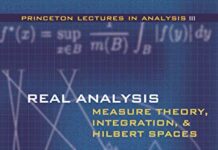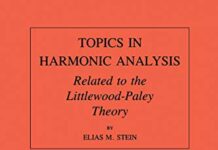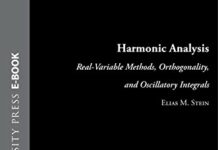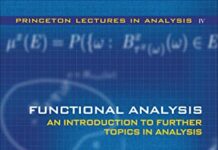
Ebook Info
- Published: 2011
- Number of pages: 321 pages
- Format: PDF
- File Size: 22.27 MB
- Authors: Elias M. Stein
Description
This first volume, a three-part introduction to the subject, is intended for students with a beginning knowledge of mathematical analysis who are motivated to discover the ideas that shape Fourier analysis. It begins with the simple conviction that Fourier arrived at in the early nineteenth century when studying problems in the physical sciences–that an arbitrary function can be written as an infinite sum of the most basic trigonometric functions. The first part implements this idea in terms of notions of convergence and summability of Fourier series, while highlighting applications such as the isoperimetric inequality and equidistribution. The second part deals with the Fourier transform and its applications to classical partial differential equations and the Radon transform; a clear introduction to the subject serves to avoid technical difficulties. The book closes with Fourier theory for finite abelian groups, which is applied to prime numbers in arithmetic progression. In organizing their exposition, the authors have carefully balanced an emphasis on key conceptual insights against the need to provide the technical underpinnings of rigorous analysis. Students of mathematics, physics, engineering and other sciences will find the theory and applications covered in this volume to be of real interest. The Princeton Lectures in Analysis represents a sustained effort to introduce the core areas of mathematical analysis while also illustrating the organic unity between them. Numerous examples and applications throughout its four planned volumes, of which Fourier Analysis is the first, highlight the far-reaching consequences of certain ideas in analysis to other fields of mathematics and a variety of sciences. Stein and Shakarchi move from an introduction addressing Fourier series and integrals to in-depth considerations of complex analysis; measure and integration theory, and Hilbert spaces; and, finally, further topics such as functional analysis, distributions and elements of probability theory.
User’s Reviews
Reviews from Amazon users which were colected at the time this book was published on the website:
⭐The preface is a long rant about mathematical terms without any sort of background on what they are or how they relate to Fourier analysis. What is Lebesgue integration? What are Riemann integrable functions? What is R^d?Chapter 1 starts off immediately saying the problem of the vibrating string, and investigation of heat flow led to the creation of Fourier analysis. No mention of what Fourier analysis even is, or what the point of Fourier analysis is first.This book so far looks like a students poorly articulated notes from his university lectures. Nothing about chapter 1 is introductory about the topic.I’ve got a nice weekend to do some reading, really disappointed by the quality of the material just a few pages in.
⭐Just started reading it. Has good introductory chapter and overall good flow of the material. Would recommend definitely.
⭐great price and book arrived a lot earlier than expected!
⭐Thorough and very easy to read
⭐I still have not read anything after chapter two, but the book look nice so far. It has a somewhat different approach by trying to avoid measure theory and still making a few comments on it for those who have already studied.
⭐Very useful book in very good conditions
⭐This is a somewhat biased review because sometimes I find myself searching for a good reference that treats a subject matter that is well-known in an easy, direct and accessible way. When I find such a book I end up relieved. This is what happened with the book by Stein and Shakarchi titled “Fourier Analysis”.In my case the search was for easy and accessible treatement of the theory of distributions in general and its applications to the wave equation in particular.There are a number of references that treat this subject matter but all the ones I know of do this from a more advanced point of view. Stein and Shakarchi’s book stems from an undergraduate lecture sequence thought at Princeton and the level of the text is indeed appropriate for the bright undergraduate who may or may not major in mathematics later on.This is unlike PDE books by Taylor, or lecture notes by Melrose, or even the tiny booklet by Friedlander and Joshi that introduce distributions and their application to PDEs (like the wave equation) and certainly unlike Hörmanders comprehensive 4-volume treatment of the whole subject matter. All these references shoot significantly higher in terms of technical sophistication and I’d certainly not recommend them to typical engineering students for self-study. As possible exception I might mention Shubin’s PDE books and encyclopedia contributions but they are more terse than the book under review and give less ground to more introductory matters.Not so the book under review. It’s an excellent, well-illustrated and clear presentation of the theory of distributions and its application to the wave equation, covering important (and old) techniques like the method of descend, which is still lacking from many contemporary engineering mathematics textbooks. Yet the book is written in a form and style to be accessible to a typical reader with engineering mathematics background while still being “modern” in it’s mathematical language.Hence I have recommended this book to many colleagues (and received enthusiastic reactions) as the only and at that quite excellent introduction ín know of to the theory of distribution, PDEs in that language and Fourier Analysis in that language that I trust to be accessible for non-specialists and as a gentle and non-threatening introduction to more technical texts.
⭐I used this book for an undergraduate-level course in Fourier analysis. It is an excellent text, although I would recommend the prospective learner to take a basic course in real analysis first (or perhaps concurrently, if the learner dares!). With my experience in analysis, it proved very readable. In fact, it strengthened my understanding of (and even interest in!) analysis, as it provides a fruitful application of the subject–one gets to see various important analysis ideas and techniques used in context. One could almost say that the text is an excellent complement to real analysis to help the ideas jell. On the other hand, perhaps it is theoretically possible to use this book as a springboard into learning analysis. The proofs do gloss over some details, which as the previous reviewer noted, can make things tough going at times… I actually found this useful (again, perhaps because of analysis experience), as it omits just enough detail to stay focused on the subject at hand (being too pedantic is likely to make those of shorter attention spans, such as myself, want to wander away), and yet supplies enough detail to remind the reader of the underlying theory, and that all this stuff is mathematically rigorously justified.The course I took was actually a brand-new course created at the undergraduate level, and was structured around the book, which had also just come out at the time. I can say with confidence that the course was a success, which is pretty unusual for something hot off the press (true, the book itself was based on lectures, but every university has its quirks…).
⭐El libro es muy didactico. Facil de leer. En mi opinion los conocimientos minimos requeridos del lector son: 1).- calculo de dos (o mas) variables, 2).- ecuaciones diferenciles y 3).- variable compleja(basico-intermedio). Vas a disfrutar el libro porque te va a revelar esas cosas que otros libros se reservan en el afan de sintetizar los temas y hacerlos muy practicos. Este libro, en cambio, NO esta (desde mi punto de vista) muy cargado al enfoque puramente teorico. Lo cual lo hace muy interesante y una buena referencia del tema.Je voulais enfin vraiment comprendre les séries de Fourier. Ce livre m’y a beaucoup aidé. L’approche est différente de la manière française. Les choses ne sont pas seulement démontrées mais expliquées. Excellent complément aux ouvrages français.
⭐
Keywords
Free Download Fourier Analysis: An Introduction (Princeton Lectures in Analysis Book 1) in PDF format
Fourier Analysis: An Introduction (Princeton Lectures in Analysis Book 1) PDF Free Download
Download Fourier Analysis: An Introduction (Princeton Lectures in Analysis Book 1) 2011 PDF Free
Fourier Analysis: An Introduction (Princeton Lectures in Analysis Book 1) 2011 PDF Free Download
Download Fourier Analysis: An Introduction (Princeton Lectures in Analysis Book 1) PDF
Free Download Ebook Fourier Analysis: An Introduction (Princeton Lectures in Analysis Book 1)





